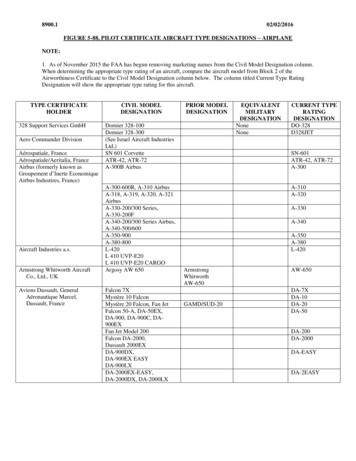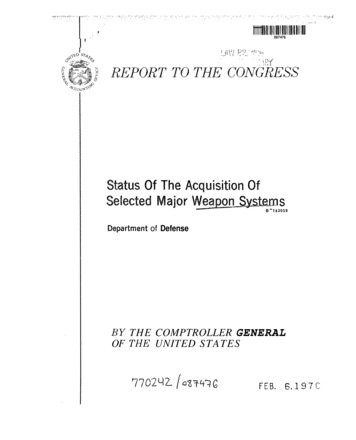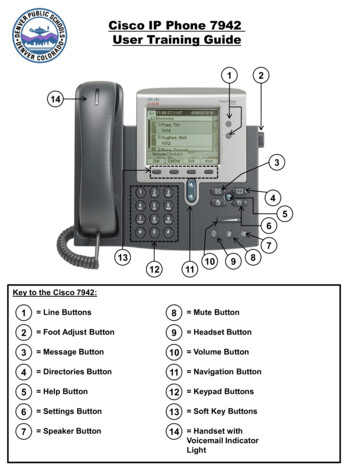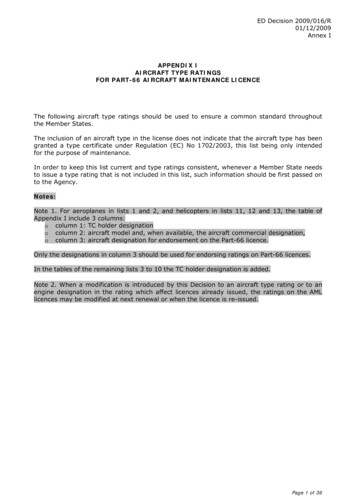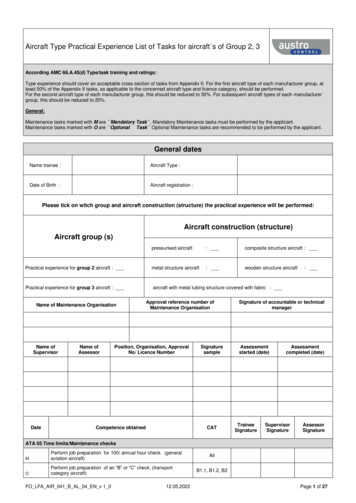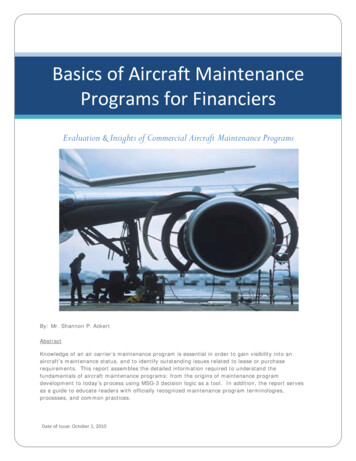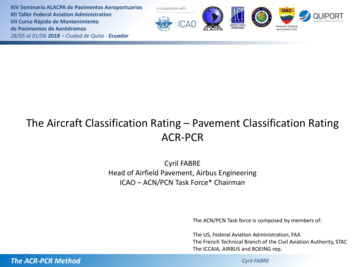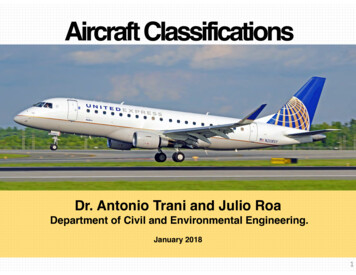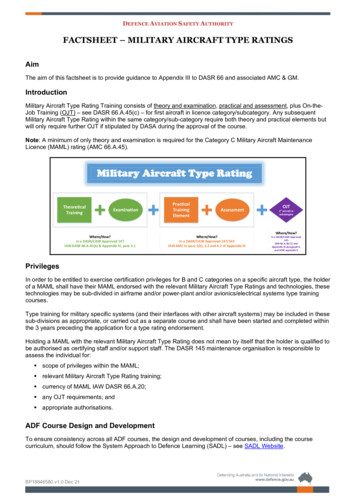
Transcription
DEFENCE AVIATION SAFETY AUTHORITYFACTSHEET – MILITARY AIRCRAFT TYPE RATINGSAimThe aim of this factsheet is to provide guidance to Appendix III to DASR 66 and associated AMC & GM.IntroductionMilitary Aircraft Type Rating Training consists of theory and examination, practical and assessment, plus On-theJob Training (OJT) – see DASR 66.A.45(c) – for first aircraft in licence category/subcategory. Any subsequentMilitary Aircraft Type Rating within the same category/sub-category require both theory and practical elements butwill only require further OJT if stipulated by DASA during the approval of the course.Note: A minimum of only theory and examination is required for the Category C Military Aircraft MaintenanceLicence (MAML) rating (AMC 66.A.45).Military Aircraft Type w?In a DASR/CASR Approved 147IAW DASR 66.A.45(b) & Appendix III, para 3.1PracticalTrainingElementAssessmentWhere/How?In a DASR/CASR Approved 147/145IAW AMC to para 1(b), 3.2 and 4.2 of Appendix IIIOJT1st aircraft insubcategoryWhere/How?In a DASR/CASR Approved145IAW 66.A.45( C) andAppendix III paragraph 6,and AMC appendix IIPrivilegesIn order to be entitled to exercise certification privileges for B and C categories on a specific aircraft type, the holderof a MAML shall have their MAML endorsed with the relevant Military Aircraft Type Ratings and technologies, thesetechnologies may be sub-divided in airframe and/or power-plant and/or avionics/electrical systems type trainingcourses.Type training for military specific systems (and their interfaces with other aircraft systems) may be included in thesesub-divisions as appropriate, or carried out as a separate course and shall have been started and completed withinthe 3 years preceding the application for a type rating endorsement.Holding a MAML with the relevant Military Aircraft Type Rating does not mean by itself that the holder is qualified tobe authorised as certifying staff and/or support staff. The DASR 145 maintenance organisation is responsible toassess the individual for: scope of privileges within the MAML; relevant Military Aircraft Type Rating training; currency of MAML IAW DASR 66.A.20; any OJT requirements; and appropriate authorisations.ADF Course Design and DevelopmentTo ensure consistency across all ADF courses, the design and development of courses, including the coursecurriculum, should follow the System Approach to Defence Learning (SADL) – see SADL Website.BP18846580 v1.0 Dec 21
Theoretical Element of the Military Aircraft Type Rating TrainingThe Theoretical element of the Type Course shall provide the person with detailed theoretical knowledge of theapplicable systems, structure, operations, maintenance, repair, and troubleshooting of the aircraft type according tothe approved maintenance data, including; The appropriate use of manuals and approved procedures, including any relevant inspections andlimitations; How to perform system, power-plant and component functional checks as specified in the maintenancemanual; Related information for the purpose of making decisions in respect of fault diagnosis and rectification withinthe scope of the maintenance manual; Describe procedures for replacement of components unique to the aircraft.Theory training shall be conducted by an appropriately approved DASR 147 Maintenance Training Organisation(MTO) or an organisation recognised by DASA, refer DASA Recognition of Other Aviation Authorities.In the case of a Category C person qualified by holding an academic degree as specified in DASR 66.A.30(a)(5),the first relevant aircraft type theoretical training shall be at the Category B1 or B2 level or at a level recognised byDASA.Theory training shall have been started and completed within the 3 years preceding the application for a MilitaryAircraft Type Rating endorsement.The minimum pass mark for the theoretical exam is 75%.The theoretical type training shall describe how the type training is delivered (i.e. classrooms, training equipment,instructors qualifications, Training Need Analysis etc.) meeting the requirements of DASR 66 and 147, asappropriate.The course content and duration shall be demonstrated by: a detailed Curriculum showing the levels for each chapter of the type training, which should be assessed forequivalence to Appendix III to DASR 66 for the relevant certifying staff category; and verifying that both content and duration are justified through a comprehensive Training Need Analysis.Evidence is required for the following elements: the teaching methods and instructional equipment; the material and documentation provided to the student; the qualification of instructors, examiners; the documentation and records provided to the student to justify the satisfactory completion of the trainingcourse and related assessment.Note: For further information about these elements, refer to the Maintenance Training Organisation exposition.Practical Element of the Military Aircraft Type Rating TrainingPractical training is a structured training activity that consolidates the knowledge gained during the theoreticalphase of type training and as such, may be performed after or integrated within the theory training. Practical training should: Address the different parts of the aircraft and its associated engines, which are representative of thestructure, the systems/components installed and the cabin. Include the use of technical manuals, maintenance procedures and the operational interfaces with theaircraft (e.g. FMC, electronic flight bag, etc). Include common maintenance and ground handling activities. Cover both type specific and generic safety elements of the aircraft’s maintenance. Develop the student’s competence in performing safe maintenance, prior to the practical assessment.BP18846580 v1.0 Dec 21Page 2 of 7
The purpose of Practical training is not to include all the maintenance tasks associated with a particular type, but arepresentative sample of them that will allow the student to acquire the required knowledge, attitude and skills tosafely carry out maintenance on that type.The practical element of the Military Aircraft Type Rating Training can be performed concurrently with the OJTelement if both are performed on the same military aircraft type and in a real maintenance environment.Practical training may be performed either following or integrated with the theoretical elements however, it shouldnot be performed before theoretical training.Table 1 summarises the Military Aircraft Type Rating Training requirements contained in DASR 66.A.45, andAppendix III to DASR 66Military Aircraft Type Rating Training requirementsAircraft GroupB1/B2 MAMLMilitary Aircraft Type Rating Training:oAll military aircraft are consideredto be complex motor-poweredaircraftoC MAMLMilitary Aircraft Type Rating Training:Theory examinationPractical assessmentPLUSOJT (for first aircraft in licencecategory/subcategory. For subsequent MilitaryAircraft Type Rating within the same category/subcategory, further OJT only if required by DASA)ooTheory examinationNote: In the case of a Category Cperson qualified by holding an academicdegree as specified in DASR66.A.30(a)(5), the first relevant aircrafttype theoretical training shall be at theCategory B1 or B2 level or at a levelrecognised by DASATable 1 – Military Aircraft Type Rating Training requirementsThe practical training may include instruction in a classroom or in simulators but part of the practical training shouldbe conducted in a DASR 145 maintenance organisation or manufacturer environment (recognised by DASA): Selected tasks should consist of a group of representative maintenance tasks drawn from the type trainingand examination curriculum, at the indicated level and shall cover all the relevant chapters described in thetable contained in paragraph 3.2 of Appendix III to DASR 66. The task curriculum must: Be distributed in order to cover all applicable S1000D chapters (e.g. ATA Chapters). Include all of the task categories (LOC, FOT, SGH, R/I, MEL, TS - Refer table below) and may includeothers deemed appropriate to the type (e.g. ‘INS’pection, ‘ADJ’ustment). Include an appropriate number of tasks in each task category for the aircraft type’s training requirementsto be met. Be sufficient to cover at least 50% of the crossed tasks in Appendix III to DASR 66, para 3.2. (Refer to“How should the 50% of tasks required for practical training be selected?” below)Note: for further information on the S100D Specification refer to the following links on the DASA Documents/Part66/S1000DSNSCodes.pdfThe duration of the practical training should ensure that the content of training required by paragraph 3.2 ofAppendix III to DASR-66 is completedA record of the tasks completed should be entered into a logbook which should be designed such that each task orgroup of tasks may be countersigned by the designated assessor. The logbook format and its use should be clearlydefined.The practical element (for power-plant and avionics systems, armaments, escape systems and other relevantmilitary-specific systems) of the Military Aircraft Type Rating Training may be subcontracted by the approved DASR147 organisation under its quality system according to the provisions of DASR 147.A.145(d)3 and thecorresponding Guidance Material.How should the 50% of tasks required for practical training be selected?When selecting the tasks, the usage of a filtering method based on the criteria similar to that described in AMC toparagraph 3.1(d) of Appendix III to DASR-66, point 5f) is recommended.The selection of 50% of tasks cannot be selected according to the glossary only (e.g. LOC, FOT, SGH, R/I, etc.).BP18846580 v1.0 Dec 21Page 3 of 7
Paragraph 3.2 of Appendix III to DASR-66 states that ‘the tasks selected shall be representative of theaircraft and systems both in complexity and diversity’. In addition, the practical training should particularlyaddress the tasks which cannot be explained by theoretical training only. While relatively simple tasks maybe included, other more complex tasks shall also be incorporated and completed as appropriate to theaircraft type. How each task is selected (LOC, SGH, etc), should be based upon the potential gains for the students’competency or its impact on safety. Availability should not be a reason to omit a pertinent task andconsideration should be made to mix ‘actual hands on’ and ‘task simulation’ to complete an important orcritical learning objective. All pertinent sub-tasks, associated with the safe completion of each main task, such as Isolatingmechanical/electrical systems, opening/closing CBs, locking flight controls, etc, should be included and theapplicable aircraft maintenance manuals used. Regarding the way to read the table in paragraph 3.2, each line aims to cover each of the main systems sothat no line relevant to the particular aircraft type should be omitted in the selection. Inside each lineapplicable to the aircraft type, half or more of the crosses can be selected. From a learning point of view,selecting 2 simple tasks as LOC and SGH would not be “representative”, while selecting LOC and TS, forexample, would be much more appropriate of the aircraft and systems both in complexity and diversity. The intent of the following tables are to provide a compliance report demonstrating that the practical typetraining meets the standard required by Appendix III to DASR 66. In particular, the tables shall indicate thepercentage of tasks effectively performed against the tasks contained in the Appendix III to DASR 66 whichare applicable to the aircraft type.The following tables are to be completed by the MTO delivering the practical type training.Glossary of the table: LOC: Location; FOT: Functional/Operational Test; SGH: Service and Ground Handling; R/I:Removal/Installation; MEL: Minimum Equipment List; TS: Trouble-Shooting.Percentage by Task TypeType oftaskNumber of tasksapplicable to the A/C typeNumber of taskseffectively performedPercentage (%) of taskseffectively performed against theapplicable tasks(should be at least 50% of the applicabletasks on each row)LOCFOTSGHR/IMELTSPercentage by ChapterChapterNumber of tasksapplicable to the A/C typeNumber of taskseffectively performedPercentage (%) of taskseffectively performed against theapplicable tasks(should be at least 50% of the applicabletasks on each row)567 .21Practical Training LogbookA Military Aircraft Type specific Practical Training Logbook (PTL) must be developed by a DASR 147 MTO,completed by the student and a certified true copy retained by the MTO delivering the training. It will record thetraining activities carried out during the practical training course and the subsequent assessment of traineecompetence.BP18846580 v1.0 Dec 21Page 4 of 7
The PTL shall list all of the applicable S1000D systems, as specified within Appendix III to DASR 66, Section 3.2.After the practical element of the Military Aircraft Type Rating Training has been completed, an assessment mustbe performed, which must comply with the following:(a) The assessment shall be performed by designated assessors appropriately qualified (AMC to Appendix III).(b) The assessment shall evaluate the knowledge and skills of the trainee.The PTL should include: Trainee attendance sheet. Course and Instructor’s details. S1000D system number and title. Aircraft Maintenance Manual or work-pack reference for each training task. A list and detailed description of the training tasks. Each task must have a method of denoting the training technique (Synthetic, Aircraft registration, Classroom,etc). Task type (R/I, LOC, SGH etc). Date of each individual task completion. Instructor signatures or stamps. Spare entries for documenting additional/replacement “ad hoc” training tasks.Note: Additional/replacement tasks must be of relevance to those they replace, be of benefit to the trainingobjective and only replace planned tasks in exceptional circumstances.EASA provide Practical type training logbook examples for both B1 and B2 PTL that can be used for guidance.Practical Instructors and AssessorsIn the majority of cases, the Practical instructor will be the same as that used for the Theory phase of the typetraining. They are a logical choice, as they possess an in-depth knowledge of the aircraft’s systems and will havedeveloped an understanding of each student’s specific academic requirements.Using the same instructor for both the Theory and Practical phases will often suit the business model of manyorganisations. In some cases, however, especially where a DASR 147 / DASR 145 affiliation exists, theorganisation may choose to utilise experienced MAML holders from their own maintenance workforce to deliver thePractical training.These individuals must be given suitable training on the organisational processes involved, particularly the use ofthe Practical training record. It is recommended that they attended a train the trainer course, whether delivered byan external or internal source, which should specifically target the training techniques required for Practical trainingand set the organisation’s bench mark for the conduct of this training. They should be familiar with the tools or thetechniques used by the training organisation to assess the competence of the practical abilities of trainees(maintenance simulators, mock up and etc.).They should be experienced and show solid judgement regarding the abilities of the assessed trainees, they musthave the required knowledge and experience of the task/s to be assessed. They should also be able to determine ifthe trainee accomplishes the tasks IAW current regulation, utilising approved procedures, maintenance practicesetc. They should be fully aware of the aim of the assessment and conduct a practical assessment in such a waythat the true abilities of the candidate are demonstrated to maintain the system.Workforce sourced Instructors will be qualified and managed by the DASR 147 organisation. Refer to DASR147.A.105 for details.They must be included in the list Instructional staff (1.5 of the MTOE) and be subject to the same Instructor recordsand update training requirements as the directly employed Instructors.Practical assessments may be conducted by either the Practical Instructor or a dedicated assessor, who hasundergone a similar training and qualification process to that detailed above.Upon completion of the PTL, it must be reviewed, assessed and approved by the relevant DASR 147 in its entirety.BP18846580 v1.0 Dec 21Page 5 of 7
OJT Element of the Military Aircraft Type RatingOJT is required for the initial type rating being sought in each licence category or sub-category: For example; If a B1.1/B2 MAML is endorsed with the P-8A type in the B1.1 category and the MAML holderwishes to add the P-8A in the B2 category, he/she will have to complete B2 related OJT representative ofthat aircraft and its systems. If the same B1.1 MAML holder adds the B1.3 category to their MAML, and wishes to add their first helicoptertype, he/she must complete OJT representative of that first helicopter type. Any subsequent Military Aircraft Type Rating within the same category/sub-category will only requirefurther OJT if stipulated by DASA during the approval of the course.A DASR 145 maintenance organisation appropriately approved for the maintenance of the particular aircraft typecan conduct OJT for that type rating. The OJT content shall be approved by DASA (Appendix III to DASR 66, sec. 6) and supported by a detailedcurriculum showing its content and recorded within detailed worksheets/logbook: OJT tasks shall be signed off by the student and countersigned by a ‘designated supervisor’; Final assessment of OJT is mandatory and shall be performed by a “designated assessor; It can be carried out in an approved DASR 145 maintenance organisation with a Category A rating(maintenance on aircraft) and the procedures for OJT should be included in the exposition (MOE chapter3.15 “OJT procedure”) approved by DASA.The OJT should include a sufficient number of tasks that are carried out under ‘one to one’ supervision (i.e. onesupervisor dedicated to one trainee) and should involve actual work task performance on aircraft/components,covering line and/or base maintenance tasks.AMC to Appendix II to DASR 66 contains a list of tasks, from which a representative sample appropriate to the typeand licence (sub-) category applied for, should be extracted and approved by the NMAA. The OJT should cover atleast 50% of this approved extracted list.Up to 50% of the required OJT may be undertaken before the aircraft theoretical Military Aircraft Type RatingTraining starts, noting that: the ADF Initial Employment Training (IET) workplace journals are the primary means of meeting the practicalrequirements for the Defence Registered Training Organisation issuance of selected MEA Unit ofCompetency: portions of these workplace journals may also be utilised as a means of meeting the requirements of OJT,as long as they are completed in a DASR 145, and on the platform/components which the individual iscompleting their Type Rating training (Appendix III to DASR 66, para 6). if these journals tasks are not carried out on the aircraft type (or its components) required for theirsubcategory, then these tasks cannot be constituted as OJT.As a minimum, the OJT procedure should describe the following elements: Content of the OJT: the list of tasks that should be performed during the OJT or a list of generic tasks andthe process how to develop a list of particular tasks out of this list of generic tasks, Qualifications of the assessor and supervisors performing the OJT, OJT logbook/worksheets format and content, OJT compliance report format and content Production planning for the implementation of OJT (how to plan the tasks), Supervision process and the assessment process, what to do if the assessment is not positive, Safe release to service of the aircraft after OJT. OJT Log Book final assessment process and associated forms: An OJT Logbook assessment is carried out on an OJT Logbook to ensure that all required tasks havebeen carried out and certified for in accordance with the OJT Logbook assessment procedure. MTOE procedure and associated documents should contain a procedure for the final assessment of anOJT Logbook and who it is completed as well as any associated forms needed and who is qualified tocarry out such assessment.Note: AMC to Section 6. of Appendix III to DASR-66 should be used when defining the content of the procedure.BP18846580 v1.0 Dec 21Page 6 of 7
Practical Assessment Vs On the Job Training (OJT) for Military Aircraft Type RatingsThe objective of OJT is to gain the required competence and experience in performing safe, effective and efficientmaintenance. The practical assessment addresses the practical portion of any type training, whereas the OJTassessment addresses the additional hands-on experience necessary in a true maintenance environment as partof the first type rating in a (sub)category, as illustrated by the table below:Practical Assessment Vs On the Job TrainingOJT AssessmentFor the purpose of DASR66.A.45(c)Practical AssessmentWhat/Who isassessedFunction ofassessor:Candidates following practical element of MilitaryAircraft Type Ratings training.Reference: 66.A.45 (a)(b); Appendix III, 4.2.; AMCAppendix IIITo perform the final evaluation of the knowledge, skillsand attitude of the trainee following the practicalelement of the type trainingReference: Appendix III 4.2.; AMC Appendix III DASR-147 Approved maintenance environment (DASR145, M.A. Subpart F with A rating,manufacturer) under the DASR-147approvalOrganisation : To evaluate if the candidate has gained the requiredcompetence in performing safe maintenance,inspections and routine work according to the aircraftdocumentation and other relevant instructions andtasks as appropriate for the type of aircraft.Reference: Appendix III, 3.2.Type ofassessment:The assessment may be: diagnostic (prior to a course), formative summative (partial or final evaluation) performed task-by-task performed as a group of tasks partly executed on simulation devices performed as a final assessmentReference: AMC to DASR-66 Appendix III 2)Qualification of theassessor:Procedureincluded in:The assessment shall be performed by designatedassessors appropriately qualified. It means that theassessors should demonstrate training and experienceon the assessment process being undertaken and beauthorised to do so by the organisation. Guidanceabout the qualification is given in AMC to DASR-66Appendix III 3.)Reference: Appendix III 4.2.; AMC to DASR-66Appendix III 3.DASR 147 MTOEReference: Appendix III 1(b); DASR-147BP18846580 v1.0 Dec 21Reference: 66.A.45 (c); Appendix III, section 6; AMC toSection 6 of Appendix IIITo conduct the final assessment of the completed OJT,whereas the candidate’s competence is indirectly justified.Reference: Appendix III, 6.; AMC to Section 6 ofAppendix III 8.Always in a maintenance organisation approved underDASR-145 with an aircraft ratingDefined maintenance environment asdescribed in the direct approved procedureby the competent authorityReference: Appendix III 1(b)Objectives:Completeness of OJTReference: Appendix III 6.; AMC to Section 6 of AppendixIII 1.To confirm the completion of the required diversity andquantity of OJT, based on the supervisor(s) reports andfeedback. It is sufficient that the completion of individualOJT tasks is confirmed by the direct supervisor(s), withoutnecessary being the direct evaluation of the assessor.Reference: AMC to Section 6 of Appendix III 7. & 8. Continuous during OJT (confirmed by the directsupervisor)Summative, as a final evaluation by adesignated assessor of the completeness of theOJT (based on the supervisor(s) reports andfeedback)Reference: AMC to Section 6 of Appendix III to DASR-66The OJT shall be assessed by appropriately qualified anddesignated assessors. It means that the assessors shoulddemonstrate training and experience on the assessmentprocess being undertaken and be authorised to do so bythe organisation. Guidance about the qualification is givenin AMC to DASR-66 Appendix III 3.)Reference: Appendix III 6.; AMC to DASR-66 Appendix III3.DASR 145 MOEReference: AMC 145.A.70 (a)Page 7 of 7
Military Aircraft Type Rating Training consists of theory and examination, practical and assessment, plus On-the- Job Training (OJT) - see DASR 66.A.45(c) - for first aircraft in licence category/subcategory. Any subsequent Military Aircraft Type Rating within the same category/sub- category require both theory and practical elements but

